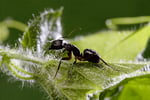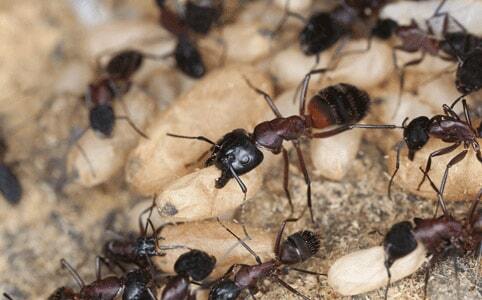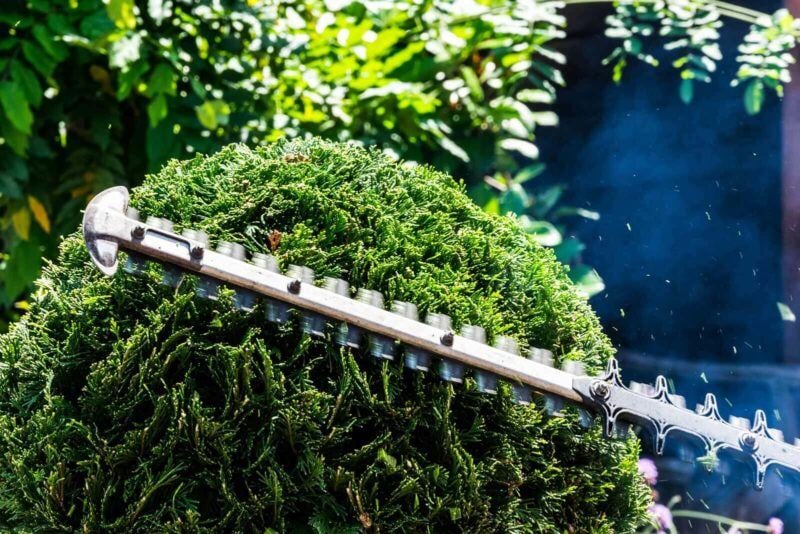 The most common types of bees in the western US are Africanized honey bees, European honey bees, carpenter bees and bumblebees. Wasps are different than bees and have distinct behaviors. Although there are 20,000 different species of wasps, the most common types of wasps in the western US are paper wasps, yellow jackets and hornets.
The most common types of bees in the western US are Africanized honey bees, European honey bees, carpenter bees and bumblebees. Wasps are different than bees and have distinct behaviors. Although there are 20,000 different species of wasps, the most common types of wasps in the western US are paper wasps, yellow jackets and hornets.
The Africanized honey bee is known more generally as the killer bee. Although it is a honey bee, it is more aggressive than the European honey bee. The killer bee is brown with black stripes and just under an inch long.
Killer bees have only resided in the United States since 1990. At their arrival, they lived in warmer temperatures in the south and have been migrating to colder destinations in the north. Although at first it was thought that they could not survive in colder temperatures, it’s now apparent killer bees can survive anywhere as long as they have food.
Killer bees are known for swarming and aggressive behavior. They will attack if they feel threatened or if their nest is destroyed. They can only sting one time and will die immediately after they lose their stinger into a person or animal.
European Honey Bee
 The European honey bee, most commonly just called the honey bee, resides all over the United States. Honey bees provide the most pollination out of all bee types. They live year-round but are more dormant in the winter than in the warmer months. Honey bees that are born in the summer months have a lifespan of just 6 weeks whereas honey bees born in the winter have a lifespan of four months. There are between 5,000 to 50,000 honey bees per hive. When they migrate they produce a large swarm, however this is rare to see.
The European honey bee, most commonly just called the honey bee, resides all over the United States. Honey bees provide the most pollination out of all bee types. They live year-round but are more dormant in the winter than in the warmer months. Honey bees that are born in the summer months have a lifespan of just 6 weeks whereas honey bees born in the winter have a lifespan of four months. There are between 5,000 to 50,000 honey bees per hive. When they migrate they produce a large swarm, however this is rare to see.
Honey bees are not as aggressive as other bee types. Like the Africanized honey bee, when it stings a person or an animal, it loses its stinger and dies. If you get stung, make sure to remove the stinger immediately. Poison from the stinger continues to be released up to one minute after the event.
Carpenter Bee
 Carpenter bees look like bumblebees and measure around an inch long. Unlike the honey bee, carpenter bees nest underground. Carpenter bees are the most-likely bee candidate to invade your walls and destroy parts of your house by their chewing and burrowing. Oftentimes carpenter bees are the hardest to remove because they can hide in hard-to-get places. In this case, it’s extremely important to call a bee removal professional to remove the hive.
Carpenter bees look like bumblebees and measure around an inch long. Unlike the honey bee, carpenter bees nest underground. Carpenter bees are the most-likely bee candidate to invade your walls and destroy parts of your house by their chewing and burrowing. Oftentimes carpenter bees are the hardest to remove because they can hide in hard-to-get places. In this case, it’s extremely important to call a bee removal professional to remove the hive.
To remove unwanted bees call Senske Pest Control at or request a free estimate.
Bumblebee
 Bumblebees are large and round and appear fuzzy. They have smaller nest sizes and usually will include less than 50 bees per nest. Because bumblebees don’t have a barbed stinger, they can sting repeatedly and not die. If stung by a bumblebee, there will not be a stinger left inside of you. Although bumblebees aren’t normally aggressive, if their nest or colony is threatened they will attack.
Bumblebees are large and round and appear fuzzy. They have smaller nest sizes and usually will include less than 50 bees per nest. Because bumblebees don’t have a barbed stinger, they can sting repeatedly and not die. If stung by a bumblebee, there will not be a stinger left inside of you. Although bumblebees aren’t normally aggressive, if their nest or colony is threatened they will attack.
Bees are most active in late summer and early fall. The easiest way to remove bees is if you can catch them in the springtime before they signal for their entire colony to follow them to your property. It’s much easier to remove 100 bees than 45,000!


.png?width=1142&height=1350&name=Holiday%20Decor%202025%20LP%20-%20548x648%20%20(1).png)












 Although bees and other
Although bees and other  The most common types of bees in the western US are Africanized honey bees, European honey bees, carpenter bees and bumblebees. Wasps are different than bees and have distinct behaviors. Although there are 20,000 different species of wasps, the most common types of wasps in the western US are paper wasps, yellow jackets and hornets.
The most common types of bees in the western US are Africanized honey bees, European honey bees, carpenter bees and bumblebees. Wasps are different than bees and have distinct behaviors. Although there are 20,000 different species of wasps, the most common types of wasps in the western US are paper wasps, yellow jackets and hornets. The European honey bee, most commonly just called the honey bee, resides all over the United States. Honey bees provide the most pollination out of all bee types. They live year-round but are more dormant in the winter than in the warmer months. Honey bees that are born in the summer months have a lifespan of just 6 weeks whereas honey bees born in the winter have a lifespan of four months. There are between 5,000 to 50,000 honey bees per hive. When they migrate they produce a large swarm, however this is rare to see.
The European honey bee, most commonly just called the honey bee, resides all over the United States. Honey bees provide the most pollination out of all bee types. They live year-round but are more dormant in the winter than in the warmer months. Honey bees that are born in the summer months have a lifespan of just 6 weeks whereas honey bees born in the winter have a lifespan of four months. There are between 5,000 to 50,000 honey bees per hive. When they migrate they produce a large swarm, however this is rare to see. Carpenter bees look like bumblebees and measure around an inch long. Unlike the honey bee, carpenter bees nest underground. Carpenter bees are the most-likely bee candidate to invade your walls and destroy parts of your house by their chewing and burrowing. Oftentimes carpenter bees are the hardest to remove because they can hide in hard-to-get places. In this case, it’s extremely important to call a bee removal professional to remove the hive.
Carpenter bees look like bumblebees and measure around an inch long. Unlike the honey bee, carpenter bees nest underground. Carpenter bees are the most-likely bee candidate to invade your walls and destroy parts of your house by their chewing and burrowing. Oftentimes carpenter bees are the hardest to remove because they can hide in hard-to-get places. In this case, it’s extremely important to call a bee removal professional to remove the hive. Bumblebees are large and round and appear fuzzy. They have smaller nest sizes and usually will include less than 50 bees per nest. Because bumblebees don’t have a barbed stinger, they can sting repeatedly and not die. If stung by a bumblebee, there will not be a stinger left inside of you. Although bumblebees aren’t normally aggressive, if their nest or colony is threatened they will attack.
Bumblebees are large and round and appear fuzzy. They have smaller nest sizes and usually will include less than 50 bees per nest. Because bumblebees don’t have a barbed stinger, they can sting repeatedly and not die. If stung by a bumblebee, there will not be a stinger left inside of you. Although bumblebees aren’t normally aggressive, if their nest or colony is threatened they will attack.


























